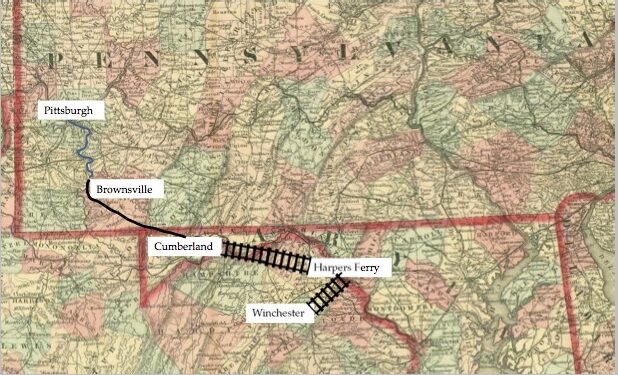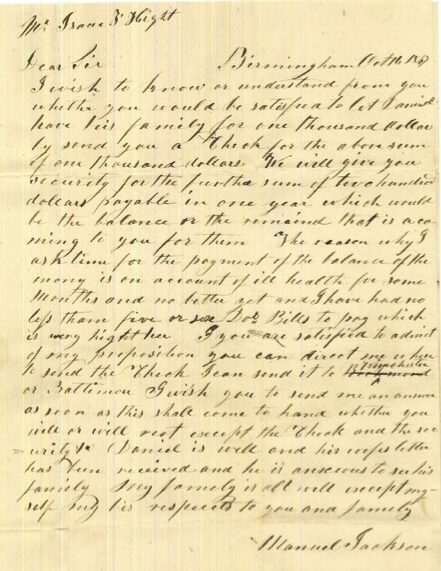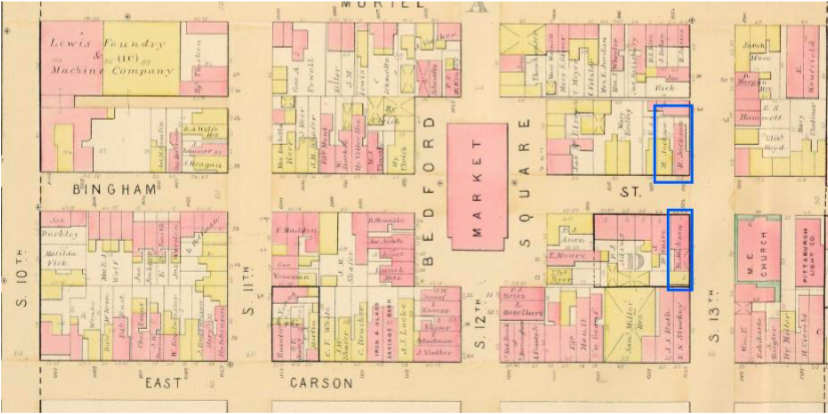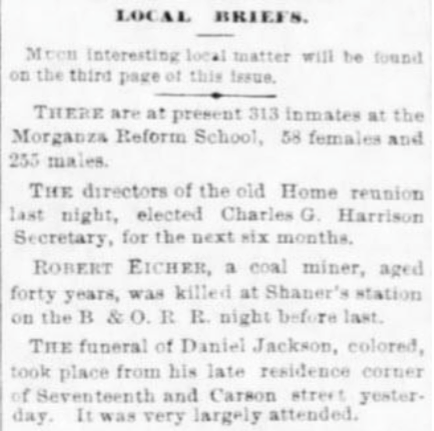Daniel is Emanuel and Hannah’s eldest son, born into enslavement on January 2, 1810 at Belle Grove Plantation. Isaac Fontaine Hite, Major Isaac Hite Jr.’s son, inherited Daniel after his father’s death in 1836. Historians know Daniel married another enslaved woman named Matilda, with whom he had at least one child, a son named Emanuel Jackson who was born in 1840. It’s likely that he and Matilda had other children while enslaved by Isaac Fontaine Hite, but historians have yet to piece together that part of their story. Daniel remained enslaved by Isaac Fontaine Hite until December 1846 when his father, Emanuel, paid $650 to Isaac Fontaine Hite for his son’s freedom, which equates to more than $25,000 in today’s currency.
Freeing Daniel
Emanuel wrote the following letter to Isaac Fontaine Hite on December 6, 1846 regarding the purchase of his son, Daniel:
Dear sir, I have purchased a Draft for six hundred and fifty dollars (in Baltimore payable to your order) at Baltimore, as you will see when you receive the same, which Draft I will mail at the same time as this letter. I have added a few lines at the bottom of the Draft in which I have desired you to execute a bill of sale for my son as soon as you receive the money, and deliver the same to him, if any thing should happen to prevent your receiving said Draft, you will please write to me as soon as you receive this letter, the Draft is made payable to your order, and could not be used by any other person without your indorsement.
Emanuel Jackson on December 6, 18461

Note: To read the letter’s full transcription, click here.

Take note of the wording: I have desired you to execute a bill a sale for my son. While the Jackson family’s story has more uplifting moments than not, Emanuel’s letter serves as a brutal reminder that enslaved men, women, and children were property of their enslavers. The harsh reality is that the emancipation of each Jackson family member was a business transaction that required the transfer of funds and a bill of sale.
As Emanuel continues his letter, he confirms the financial and legal arrangements with Isaac Fontaine Hite and provides detailed travel instructions for Daniel:
I wish Daniel when he comes to Winchester to take Rail Road cars for Harpers Ferry, for which he will have to pay two dollars then from Harpers Ferry to Cumberland, for which he will have to pay Four dollars, then take the stage for Brownsville which will cost him Five dollars, then take the Steam Boat for Pittsburgh, which in the Rail Road Cars, he will try to get some Gentleman to speak for him at the stage office in Cumberland, as colored people are not taken notice of when passengers are plenty. I would also advise him to prepare himself with some Bread and cheese before starting on his Journey as he may find it difficult to get his meals on some parts of his Journey.
Emanuel Jackson on December 6, 18464

Emanuel’s concern for Daniel is palpable in his letter, from which trains to take, to how much money he needs at each stop in his route, to how to handle catching the train in Cumberland, to what food to prepare ahead of time. There are several reasons why Emanuel seems worried. The first is that Daniel may not have ever left the Middletown, Virginia area where he was enslaved, so he would simply be unaware of where to go and how to get to Pennsylvania. The second is that Emanuel knew the hardships of what it meant to be an African American traveling in 1846 America, so he was trying to pass along words of wisdom to Daniel so that he could have as seamless of a trip as possible. His intentions were likely a combination of the two – a father’s love for his son and a concern for his safety during the trip.
Freeing Daniel’s family
Less than a year later, in October 1847, Emanuel wrote another letter to Isaac Fontaine Hite to see if he would be willing to sell Daniel’s enslaved family’s freedom, too, offering to pay $1,000 for Matilda, who was roughly 33-years-old at the time. Using census records, historians believe that Emanuel also bought the freedom of Daniel and Matilda’s two enslaved sons: Emanuel, born circa 1842, and Robert, born circa 1846.
Think about this census data for just a minute. If Robert was born around 1846, then Daniel, despite being free, was leaving behind not only his wife and young son, but also his infant son – his enslaved infant son.

Note: To read the letter’s full transcription, click here.
Emanuel’s letter is short but full of insight, from making an offer to Isaac Fontaine Hite to buy his daughter-in-law and grandson, to negotiating how to handle the financial transaction, to sharing Daniel’s anticipation to be reunited with his family once more.
Isaac Fontaine agreed to Emanuel’s proposition because by 1860, Daniel and his wife, Matilda (last name Gordon), were living in Pittsburgh, PA. They had one more son named Louis William born on April 15, 1848. Their third son’s birth in April 1848 means that Matilda was pregnant when her father-in-law, Emanuel, wrote to Isaac Fontaine Hite offering to buy their family’s freedom, so Emanuel ultimately bought the freedom of all three of Daniel and Matilda’s sons.
Think like a historian!
Major Isaac Hite Jr’s Commonplace Book has an entry for a Matilda born in 1815, so it’s possible that this is the same Matilda. Maybe Isaac Fontaine Hite inherited her, too, after his father died.

Daniel’s Real Estate
In researching the Jackson family, one of the reoccurring themes is their unparalleled tenacity. In the 1870 census, Daniel is listed as a teamster, a person who drove horses to pull wagons, and had a personal estate valued at $1000, which equates to $22,749 in today’s currency, and owned real estate valued at $15,000, which equates to $341,235. To put it in perspective, Daniel’s neighbor was a medical doctor with real estate valued at $10,000 and a personal estate also valued at $1000, so he had really built a successful life in Pittsburgh after his father bought his freedom from enslavement. By 1880, just one year before he died, his occupation is listed as “Old Gent,” and he, Matilda, and their youngest son, Louis William, are living on 13th St in the south side of Pittsburgh.

Daniel’s death
Daniel died in Pittsburgh on September 6, 1881 at 71-years-old.

Think like a historian!
In looking at his death certificate, historians believe that Daniel died a teamster’s death: the primary cause was “upsetting of wagon” and the secondary cause “fracture of ribs, pneumonia.”

Because he didn’t have a will at the time of his death, his three sons created a written agreement in which Emanuel and Robert each received one tract of their father’s land in exchange for supporting their brother, Louis William, whom we think may have been paralyzed in an accident between 1870 and 1880. Additionally, their mother, Matilda, relinquished her rights to Daniel’s land in exchange for $2,400 ($70,120 in today’s currency) from her sons, Emanuel and Robert.

Matilda’s tragic death
Tragedy struck the family again when Matilda was hit by a streetcar in Pittsburgh and succumbed to her injuries on September 13, 1894. She’s buried in Allegheny Cemetery in Pittsburgh, Pennsylvania, along with other members of the Jackson family.
Return to The Jackson Family
Go to Emanuel & Catharine
- This quote comes from a manuscript that is reproduced with permission of the Stewart Bell Jr. Archives, Winchester, Virginia. It is in collection THL 251, Box 1, Correspondence and business papers, 1845-1846.
- This manuscript is reproduced with permission of the Stewart Bell Jr. Archives, Winchester, Virginia. It is in collection THL, Box 1, Correspondence and business papers, 1845-1846.
- This manuscript is reproduced with permission of the Stewart Bell Jr. Archives, Winchester, Virginia. It is in collection THL, Box 1, Correspondence and business papers, 1845-1846.
- This quote comes from a manuscript that is reproduced with permission of the Stewart Bell Jr. Archives, Winchester, Virginia. It is in collection THL, Box 1, Correspondence and business papers, 1845-1846.
- This map was created by historians at Belle Grove using the letter that Emanuel Jackson (1786) wrote to Isaac Fontaine Hite regarding Daniel Jackson’s journey to Pittsburgh.
- This manuscript is reproduced with permission of the Stewart Bell Jr. Archives, Winchester, Virginia. It is in collection THL, Box 1, Correspondence and business papers, 1845-1846.
- Atlas of the City of Pittsburgh: From Official Records, Private Plans, and Actual Surveys vol. 5, (Philadelphia: G. M. Hopkins, 1890), plate 1, “South Side Flats.”
- Daniel Jackson death notice, Daily Post (Pennsylvania), 9 September 1881, p. 4, col. 6.
- Ancestry.com. Pittsburgh, Pennsylvania, U.S., Deaths, 1870-1905 [database on-line]. Lehi, UT, USA: Ancestry.com Operations, Inc., 2019.
- “Died from Her Injuries,” Pittsburgh Press (Pennsylvania), 13 September 1894, p. 7, col. 4.